How to install a light switch: step-by-step instructions for connecting typical switches
Each house has switches, and not one at a time. All of us have long been accustomed to these small devices and consider them an integral part of our everyday life. It may seem that they are all equally designed and extremely easy to install. However, this is not at all the case - the devices are very diverse.
You must admit that it will not be out of place for any home master to find out which model is better to use and how to install a light switch so that the device works flawlessly.
The article is devoted to the solution of these questions. We will designate the operational features of different switches, as well as provide detailed installation instructions for open, hidden and walk-through models.
The content of the article:
- Wiring: open or hidden option
- Switch wire switching method
- The main types of switches
- How to choose the "right" place for the switch
- General circuit breaker installation
- Overhead switch installation procedure
- Installation Instructions for Hidden Switch
- Connecting the passage switch
- Conclusions and useful video on the topic
Wiring: open or hidden option
Despite the fact that installing a switch may seem very simple, there are a large number of nuances that a beginner electrician must know.
First you need to determine the type of wiring.

Electrical wiring is a must-have item in every home.
There are two types of it:
- Open. Wires are laid over the wall. They can be fixed with decorative rollers or closed with plastic cable channels.
- Hidden. A wire is laid inside the wall. To do this, channels are inserted into its surface, into which the cable is laid. After laying, the strobes are closed with a solution.
For each type of wiring, a different type of switch is used. For an open system, overhead models are chosen that are placed directly on the wall. They are easily recognizable because they are very visible on the surface.
This type of circuit breaker appeared the very first and has changed little over the past decades. For closed wiring, internal or embedded models are used.
They are installed in a recess, which is previously prepared in the wall. Hole sizes are selected depending on the dimensions of the switch. It is mounted inside the recess with the help of special foot-struts.
There is another kind of built-in devices - with mounting plates. This option is more convenient to install. After installation, internal switches practically do not protrude above the wall plane.
Switch wire switching method
Before starting the installation of the switch, you need to know that the internal wires of the wires in the device can be different. Two switching methods are used.
Screw type clamp
The screw type contact is tightened with a screwdriver. Previously, approximately 2 cm of the wire is cleaned of insulation, then it is located under the terminal and fixed. It is imperative that there is not a millimeter of insulation left under the terminal, otherwise it will start to melt, which is very dangerous
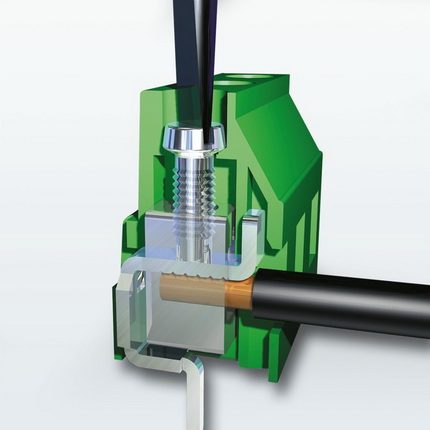
This connection is especially good for aluminum wires. They are heated during operation, which eventually leads to deformation. The contact in this case begins to warm up and sparkle.
To solve the problem, it is enough to tighten the screw. The wires, sandwiched between two flat contact plates, “snap into place” and the device will work without heating and sparking.
Non-screw type clamp
Represents contact with a clamping plate. It is equipped with a special button that adjusts the position of the plate. The wire is stripped of insulation by 1 cm, after which it is inserted into the contact hole and clamped. The whole procedure is very quick and easy.
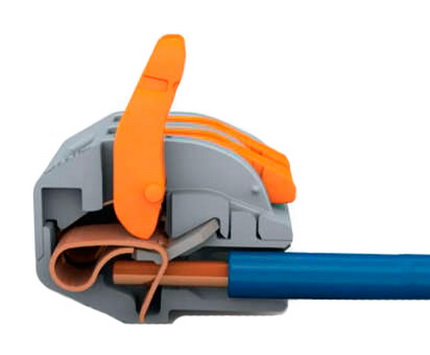
The terminal design provides high reliability of the resulting connection. Non-screw terminals are best used for copper wiring.
Admittedly, screw and non-screw clamps provide approximately the same reliability and quality of connections. However, the second option is easier to install. It is his experienced specialists who recommend using novice electricians.
The main types of switches
The time has long passed when all models were about the same and differed only in appearance. Today, the manufacturer produces a variety of types of switches. By type of shutdown / on, all of them can be divided into several groups.
No. 1: Keyboard Instruments
Very simple and reliable design. The basis of the device is a swinging mechanism, which is drawn by a spring. When you press a key, it closes the contact, which turns on or off the electrical device.
For the convenience of consumers, one, two and three-key switches are available.This makes it possible to control not only one but several lamps at once.
No. 2: Switches or Rocker Switches
Externally, these devices are indistinguishable from their keyboard counterparts, but the principle of operation is completely different. When a key is pressed, the devices open one electrical circuit and transfer the contact to another.
This allows simultaneous lighting control from two, three or even more places. Complex circuits involving more than two switches are complemented by cross elements.
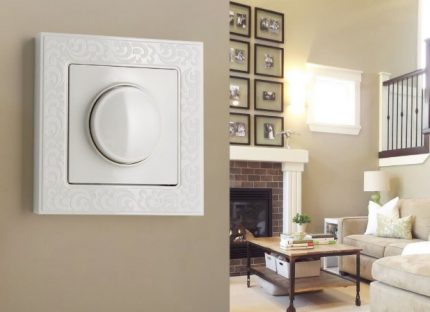
No. 3: Dimmers or dimmers
A switch that allows you to adjust the lighting intensity. The external panel of such a device is equipped with keys, a rotary button or infrared sensors.
The latter option assumes that the device can receive signals from the remote control. Difficult dimmers can perform several functions: activate the dimming mode, simulate the presence, turn off the lighting at a given time.
Criteria for choosing a dimmer switch are described in this article.
No. 4: Switches with integrated motion sensor
Instruments respond to movement. The appearance of people is recorded by a sensor that activates the lighting and turns it off when there is no movement. To work with the switch, an infrared sensor is used, which is able to analyze the intensity of infrared radiation and distinguish a person from other objects.
Multifunctional motion switch capable of not only turning on lighting devices, but also activating video cameras, sirens, etc.
No. 5: Touch Type Devices
Turn off / on the lighting with a light touch of the sensor. Varieties are produced that work when they are held by hand near their hull. The main difference between touch switches and traditional analogs is the availability of microcircuits.
This eliminates the risk of a short circuit, which significantly increases the life of both the switch itself and the lighting fixture.
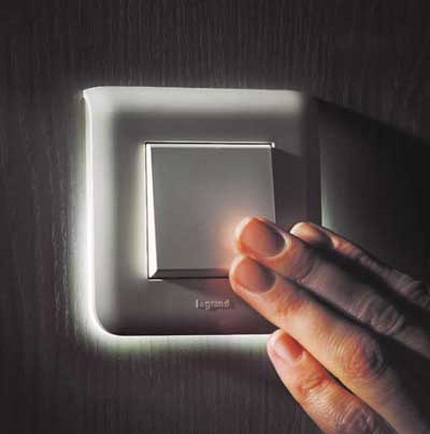
How to choose the "right" place for the switch
The choice of location for installing the switch is a personal matter for each owner. However, there is a set of industry requirements governing this issue. This is due to the fact that the wiring is quite an expensive undertaking and it is too expensive and too troublesome to redo it every time.
Experts recommend installing all the switches in the house at the same height and the switching position for all should be common.
Devices are usually mounted at the height of door handles, which correlates well with the development of muscle memory. Thus, entering a room, a person presses a key automatically, without even noticing it.
Another important point: the switch in the room should be positioned so that between it and the doorway there is a distance of about 15-20 cm. So a person can grab the doorknob with one hand and press the key with the other hand.
For living rooms, it is customary to install switches only indoors. For common areas, such as bathrooms, closets or corridors, the switches most often used outside the room are used.
If the house has small children, do not “pull up” the switches up. The troubled period when the baby will "indulge" with the light will pass very quickly, and the inconvenience of the location of the switches will remain for a long time.

General circuit breaker installation
Failure to comply with the basic installation rules, even such a simple device as a switch, can lead to very unpleasant consequences. Among which are overheating and sparking with a possible subsequent circuit, as well as voltage that is stored in the wiring.
This is fraught with electric shock, even if you just need to replace the lamp with the lights off.
Therefore, before connecting the switch, it is worth remembering the basic elements of the connection:
- Zero core. Or, in the jargon of electricians, zero. It is displayed on the lighting device.
- Phase assigned to the switch. In order for the lamp to go out and light up, the circuit must be closed within the phase conductor. It is important to remember that if the switch-off device is brought to the opposite to zero, it will work, but the voltage will remain. Therefore, to replace the lamp, for example, you will have to disconnect the room from the power supply.
- The phase assigned to the lamp. When a key is pressed, the circuit will close or open at the point of breaking of the phase channel. This is the name of the section where the phase wire leading to the switch ends, and the segment stretched to the bulb begins. Thus, only one wire is supplied to the switch, and two to the lamp.
It should be remembered that any connection of conductive sections must be carried out in a junction box. It is extremely undesirable to carry them out in a wall or in plastic channels, since there will certainly be complications with the identification and subsequent repair of damaged fragments.
If there is no junction box near the mounting location of the switch, you can extend zero and phase from the input shield.
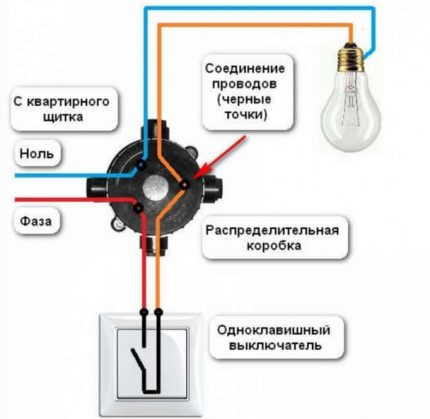
All of the above rules apply to a single-key switch. They also apply to multi-key devices with the difference that a fragment of the phase wire from the lamp that it will control is supplied to each key.
The phase stretched from the junction box to the switch will always be only one. This statement is true for multi-keyboard devices.
Replacement of the circuit breaker or its installation from scratch is carried out only in the presence of a fully formed conductive circuit.
In order not to make a mistake in working with wiring, you need to know the marking and color of current channels:
- Brown or white wire insulation is indicated by a phase conductor.
- In blue - zero core.
- Green or yellow - grounding.
Installation and further connection is made according to these color tips. In addition, the manufacturer can affix a special marking on the wires. All connection points are denoted by the letter L and a number.
For example, on a two-gang switch, the phase input is indicated as L3. On the opposite side are the lamp connection points, referred to as L1 and L2. Each of them will need to be displayed on one of the lighting devices.
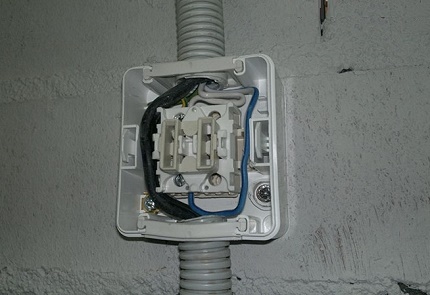
Overhead switch installation procedure
Such devices are used for open type wiring and where for some reason it is impossible to make a hidden connection.
Consider the installation procedure as an example of a single-key switch of a complete factory assembly. To connect it, you need to turn off the power supply to the apartment, and then sequentially perform the following operations.
Step 1: disassembling the device
We take a slotted screwdriver, very carefully lift the device key and remove it. After that, just as carefully, trying not to damage, we remove the protective decorative cover. It remains for us to disconnect the working mechanism from the plate of the socket. Perform this operation.
Step 2: Designate an Installation Location
On the base plate, the manufacturer must make holes for fixing the device. They need to be marked on the wall. To do this, take the sapling, apply it to the surface and use a pencil to mark the line of the upper edge.
Using the level, we check its horizontal, otherwise we will not be able to evenly install the switch. After that, we again apply the plate to the wall and mark the attachment points.
Step 3: Install the Socket Plate
Further actions depend on the material the wall is made of. If it is soft wood, we fasten the base with galvanized screws. If the base is made of harder materials, you will have to drill holes in it.
We try to do all the work accurately so that you do not have to make additional holes. The plate is securely fastened to the wall.
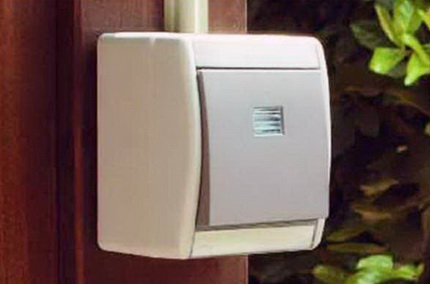
Step 4: Connect the wires
We determine the type of switching contacts and, in strict accordance with it, cut and strip the wires. Required remove all insulationso that it does not subsequently melt and does not cause malfunctions in the operation of the device.
We check that the wires reach the terminals extremely accurately, it is undesirable that there is excess. In accordance with the marking and color of the wires, we connect them with the desired contacts.
Step 5: assemble the device
First, we need to make sure that the wires are connected correctly, for which we test them with a screwdriver-multimeter or other device. Having found out that everything is assembled correctly, we take the switch mechanism and install it in place.
Then we return the protective decorative cover and, finally, snap the key. Check the operation of the device.
Installation Instructions for Hidden Switch
The design of the hidden devices differs in the shape of the socket and the decorative cover. The first is made in the form of a bowl, inside of which the switch mechanism is placed. The cover is in the form of a small panel or even a frame.
Accordingly, the connection diagram of such a switch will be slightly different. Before installation, you need to purchase a power socket, which is sold separately from the switch.

You need to know that structures for brick and concrete walls are somewhat different from products intended for installation in drywall. Be sure to consider this when buying. Installation of the hidden switch is carried out in the following sequence.
Step 1: Preparing a Place for a Socket
The product should be inserted into a pre-prepared niche, the dimensions of which are slightly larger than the undergrowth. For its implementation, a special nozzle in the form of a crown on a perforator or drill is required. The diameter of the crown should be slightly larger than the diameter of the undergrowth.
For double switches, two niches are performed, which then will need to be interconnected. This subsequently fits a special double socket.
Step 2: Installing the Socket correctly
Disconnect the room. To the place of installation of the switch we bring the wires, laying them in prepared in advance strobes. Can now install a socket and wiring inside it.
For this, there is a special hole in the body of the product. We fix the structure in place. In concrete or brick, we do this with plaster, in drywall we put holding brackets, fix them with two self-tapping screws, screwed to the stop.
Step 3: Put the switch in place
First, we disassemble the design. We take a slotted screwdriver and gently pry the key with it, so that the element can be removed. Then we remove the decorative protective panel. We still have a mechanism mounted on a metal plate.
Now you need to connect the wires. We measure and cut them. You need to know that in this case it is necessary to leave a small margin of the length of each wire.
We clean the ends of the wires and connect them, then we put them inside the socket and put in place the switch mechanism. Install the mounting plate. Depending on its type, this can be done in two ways: either spread apart the spacers and fix them with special screws, or fix with two self-tapping screws.
After that, the tester checks the correct connection of the device, we put on a decorative panel and put the key.
Connecting the passage switch
To correctly set the cross over light switch, you need to accurately imagine the principle of its operation. In the simplest case, when the key is pressed, the device will open one circuit and close the other.
On the reverse side of this type of circuit breaker, the manufacturer always shows the device operation diagram. Consider the installation procedure for the simplest single-key walk-through switch.
For installation, we need a three-core cable, each of which will have a color factory marking. Be sure to turn off the electricity before starting work.
We sequentially perform the following operations:
- On the passage switch, determine the common terminal.
- On the one of the switches that is located closer to the junction box, we withdraw the phase core and connect it to the common terminal.
- The two remaining wires are connected to the output terminals of the passage switch. In this case, we definitely remember what color the core is connected to which terminal.
- In the junction box, we connect the phase from the luminaire to the phase wire of the second pass-through switch.
- Guided by the color of the braid, we connect the two remaining wires with wires of the same color from the first switch.
After - in the junction box we find the grounding and neutral wires and connect them to similar cables extending to the lamp.
We carry out all twists very carefully, if necessary we tin and isolate all bare sections of wires with high quality. It is strongly recommended not to connect copper and aluminum wires into a common twist.
Next, proceed to installation of a passage switch, which will be similar to the above procedures. We disassemble the device, in accordance with the diagram, connect the wires to it, put the mechanism in place and fix it.
We replace the protective panel and the key. Now you can begin to check the operability of the assembled circuit. Make sure that both switches can control the lamp. That is, each of the devices can turn off or turn on the lamp, regardless of the position of the other device.
Each switch of the passage switch must turn off / on the lamp. If not, you should look for and correct the error.
A more complex variation of the single-key rocker switch is two-gadget device. In fact, these are two single transitional devices assembled in a common housing.
This design allows you to control multiple lamps at once. The device is connected with a three or six-wire cable.
Conclusions and useful video on the topic
How to install a single-key overhead switch:
The sequence of work when replacing the device:
Rules and sequence for connecting the two-key switch:
Installation and connection of the circuit breaker is one of the simplest electrical work. Special knowledge and skills are practically not required here, but you should not be irresponsible to this event either. Electricity does not forgive even the smallest mistakes.
Therefore, those who do not have experience in carrying out such work should seek the help of specialists or more experienced home craftsmen.
Do you have practical skills in installing light switches? Share your knowledge, talk about the nuances of installation and connection or ask questions on the topic in the comments below.

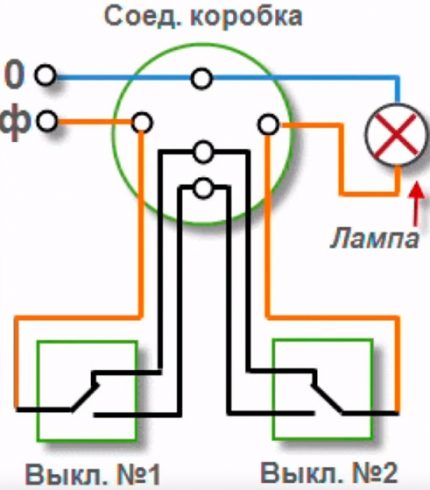
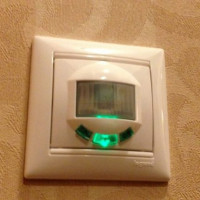 Switch with motion sensor: how to choose and install a light switch with a sensor
Switch with motion sensor: how to choose and install a light switch with a sensor 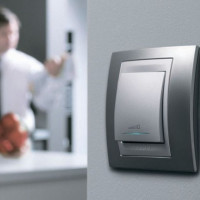 Types and types of light switches: an overview of connection options + analysis of popular brands
Types and types of light switches: an overview of connection options + analysis of popular brands 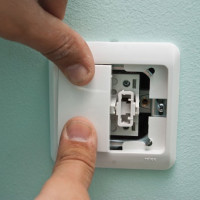 How to disassemble a light switch for repair or replacement
How to disassemble a light switch for repair or replacement 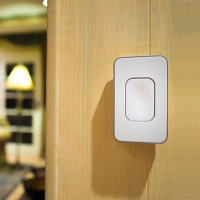 Wireless light switch: selection criteria + review of the best models
Wireless light switch: selection criteria + review of the best models 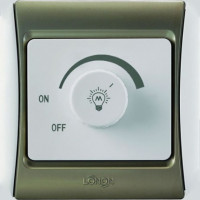 Light switch with dimmer: device, selection criteria and manufacturers review
Light switch with dimmer: device, selection criteria and manufacturers review  Touch light switch: why is it needed, types, marking, selection and connection
Touch light switch: why is it needed, types, marking, selection and connection  How much does it cost to connect gas to a private house: the price of organizing gas supply
How much does it cost to connect gas to a private house: the price of organizing gas supply  The best washing machines with dryer: model rating and customer tips
The best washing machines with dryer: model rating and customer tips  What is the color temperature of light and the nuances of choosing the temperature of the lamps to suit your needs
What is the color temperature of light and the nuances of choosing the temperature of the lamps to suit your needs  Replacement of a geyser in an apartment: replacement paperwork + basic norms and requirements
Replacement of a geyser in an apartment: replacement paperwork + basic norms and requirements
He started putting switches in his early youth when he lived in a dormitory: he needed a switch next to the bed. Then he made open wiring so as not to bother and pick walls. Now the aesthetic component is coming to the fore. Therefore, I always ask my wife to draw in advance the arrangement of equipment on the plan in order to make hidden wiring. I always observe safety precautions - electricity does not endure haste.
Nevertheless, the information of the post is somewhat out of context, therefore, it will probably be understood only by professional electricians. It is clear that for the installation of the circuit breaker, it is necessary to disconnect the mains power for safety and install the circuit breaker so that the phase wire is disconnected and the wires are tightened to the contacts harder. I would still like to read about the installation of switches in the context of the installation of the electrical network in an apartment or residential building. (Installation of wiring directly from the switchboard, installation of lamps, switches and sockets, with detailed diagrams.) I think it would be even more interesting, especially for more advanced visitors to your resource.
Good afternoon, Alexander.
This site has a section "Wiring»With articles of interest to you. For instance, "How to conduct wiring in the apartment with your own hands from the shield". Electricians become professionals by studying a certain amount of theoretical material, which is then supported by practical work. Just by reading articles, books, do not learn anything.